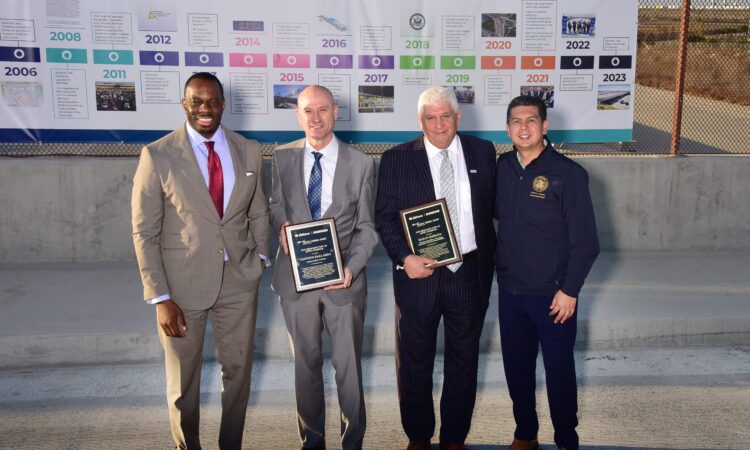CA Highlights Key Investments to Improve Crossings, Wait Times at US/Mexico Border


California State Transportation Agency Secretary Toks Omishakin and the San Diego Association of Governments Saturday joined state and local officials on the Siempre Viva Road Interchange to commemorate the completion of the roadway network connecting to the future Otay Mesa East Port of Entry.
This is considered a critical investment in border region improvements to facilitate the movement of people and goods.
During the ceremony, the agencies reiterated their shared commitment to keep people and goods flowing safely and efficiently between California and Mexico. To date, more than $1.5 billion of federal, state, and local transportation funding has been invested in Otay Mesa alone.
“This interchange is the final piece of the puzzle to help keep goods and people moving when the new port of entry opens by the end of 2026,” said California State Transportation Agency Secretary Toks Omishakin. “With strong collaboration on both sides of the border, the finish line is in sight to shorten wait times, curb harmful pollution, and bolster binational trade.”
To download the b-roll footage of the event, please use this link.
Please use this link to download footage of the full press conference.
The completion of the roadway network supporting the future port of entry represents the culmination of two decades of work across all levels of government to create an innovative new border crossing that will transform the movement of people and goods throughout the San Diego-Baja California region. Other infrastructure improvements as part of the project include the construction of three freeway-to-freeway connectors, seven bridges, and 2.4 miles of new highway, along with the creation of 181 acres of environmental protection sites, installation of seven air quality monitors and 17 miles of fiber optic cables, and the relocation of international water and gas lines.
The Siempre Viva Road Interchange, the last major infrastructure component of the newly completed roadway network, will serve as a transition between State Route 11 (SR 11) and the future 15-lane toll plaza connecting to the Otay Mesa East Port of Entry.
Once the new port of entry begins operations, SR 11 will operate as a variable-tolled highway, providing travelers the ability to get to the border more quickly by paying a fee. The goal is to operate Otay Mesa East with an average 20-minute wait time between arriving and reaching primary inspection, which will also help lower wait times at nearby border crossings.
Caltrans and SANDAG are currently designing the new port of entry facility with the U.S. Customs and Border Protection and General Services Administration. With final agreements from the federal government, the region can begin construction of the port of entry and be open by late 2026.
In addition to the new port of entry, Caltrans and GSA are investing in several other projects to facilitate goods movement and enable fast, predictable, and reliable border crossings and wait times. This includes the expansion of the Calexico West Land Port of Entry and the addition of a third inspection lane at the Otay Mesa Commercial Vehicle Enforcement Facility, which is expected to be completed in December.
About the State Route 11/ Otay Mesa East Port of Entry Project:
The State Route 11 /Otay Mesa East Port of Entry Project is a joint venture between SANDAG and Caltrans, in collaboration with state and federal partners in the U.S. and Mexico, to create a 21st-century border crossing for the San Diego-Baja California mega-region that will enhance regional mobility and fuel economic growth and binational trade.
The proposed border improvements will provide fast, predictable, and secure border crossings by constructing a four-lane tolled road connecting directly to a state-of-the-art Customs & Border Protection Land Port of Entry and a California Highway Patrol Commercial Vehicle Enforcement Facility.
Additional improvements include:
· New border wait-time detection system.
· Advanced traveler information to improve route planning.
· Optimized port of entry capacity to decrease congestion and wait times.
